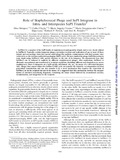Mostrar el registro sencillo del ítem
Role of staphylococcal phage and SaPI integrase in intra- and interspecies SaPI transfer
| dc.creator | Maiques, Elisa | es_ES |
| dc.creator | Ubeda, Carles | es_ES |
| dc.creator | Tormo Más, María Ángeles | es_ES |
| dc.creator | Ferrer, María Desamparados | es_ES |
| dc.creator | Lasa Uzcudun, Íñigo | es_ES |
| dc.creator | Novick, Richard P. | es_ES |
| dc.creator | Penadés, José R. | es_ES |
| dc.date.accessioned | 2019-01-23T11:16:21Z | |
| dc.date.available | 2019-01-23T11:16:21Z | |
| dc.date.issued | 2007 | |
| dc.identifier.issn | 0021-9193(Print) | |
| dc.identifier.issn | 1098-5530 (Electronic) | |
| dc.identifier.uri | https://hdl.handle.net/2454/32084 | |
| dc.description.abstract | SaPIbov2 is a member of the SaPI family of staphylococcal pathogenicity islands and is very closely related to SaPIbov1. Typically, certain temperate phages can induce excision and replication of one or more of these islands and can package them into special small phage-like particles commensurate with their genome sizes (referred to as the excision-replication-packaging [ERP] cycle). We have studied the phage-SaPI interaction in some depth using SaPIbov2, with special reference to the role of its integrase. We demonstrate here that SaPIbov2 can be induced to replicate by different staphylococcal phages. After replication, SaPIbov2 is efficiently encapsidated and transferred to recipient organisms, including different non-Staphylococcus aureus staphylococci, where it integrates at a SaPI-specific attachment site, attC, by means of a self-coded integrase (Int). Phages that cannot induce the SaPIbov2 ERP cycle can transfer the island by recA-dependent classical generalized transduction and can also transfer it by a novel mechanism that requires the expression of SaPIbov2 int in the recipient but not in the donor. It is suggested that this mechanism involves the encapsidation of standard transducing fragments containing the intact island followed by int-mediated excision, circularization, and integration in the recipient. | en |
| dc.description.sponsorship | This work was supported by grant BIO2005-08399-C02-02 from the Comisión Interministerial de Ciencia y Tecnología (C.I.C.Y.T.), by grants from the Cardenal Herrera-CEU University, from the Conselleria de Agricultura, Pesca i Alimentació (CAPiA), and from the Generalitat Valenciana (ACOMP06/235) to J.R.P., and by NIH grant R01-AI-22159 to R.P.N. Fellowship support for Carles Úbeda from CAPiA and for Elisa Maiques from the Cardenal Herrera-CEU University is gratefully acknowledged. | en |
| dc.format.extent | 9 p. | |
| dc.format.mimetype | application/pdf | en |
| dc.language.iso | eng | en |
| dc.publisher | American Society for Microbiology | en |
| dc.relation.ispartof | Journal of Bacteriology, vol. 189, nº 15, aug. 2007, p. 5608–5616 | en |
| dc.rights | © 2007, American Society for Microbiology. All Rights Reserved. | en |
| dc.subject | SaPIbov2 | en |
| dc.subject | Genetic | en |
| dc.title | Role of staphylococcal phage and SaPI integrase in intra- and interspecies SaPI transfer | en |
| dc.type | info:eu-repo/semantics/article | en |
| dc.type | Artículo / Artikulua | es |
| dc.contributor.department | IdAB. Instituto de Agrobiotecnología / Agrobioteknologiako Institutua | es |
| dc.rights.accessRights | info:eu-repo/semantics/openAccess | en |
| dc.rights.accessRights | Acceso abierto / Sarbide irekia | es |
| dc.identifier.doi | 10.1128/jb.00619-07 | |
| dc.relation.publisherversion | https://doi.org/10.1128/jb.00619-07 | |
| dc.type.version | info:eu-repo/semantics/publishedVersion | en |
| dc.type.version | Versión publicada / Argitaratu den bertsioa | es |


